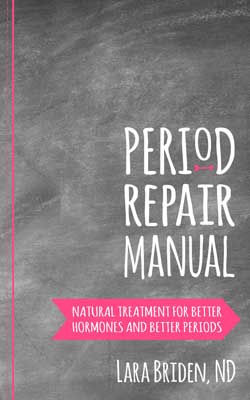Guest Post by Dr. Lara Briden
 My new book Period Repair Manual begins with some warm words about Period Apps. I’m talking about the smart phone applications that let us tap in data about our period start date, bleed duration, and symptoms such as spotting, breast tenderness, and mood.
My new book Period Repair Manual begins with some warm words about Period Apps. I’m talking about the smart phone applications that let us tap in data about our period start date, bleed duration, and symptoms such as spotting, breast tenderness, and mood.
Of course we could always do the same thing with old-fashioned pen and paper, but period apps are different somehow. They’re right there in our bags. They’re often on our hand. That makes it so easy to check in with our body’s information on a daily basis. That makes it fun to track periods—almost like a game.
I love period apps because they have made periods seem less threatening. They have made periods seem normal (which of course they are). As a naturopathic doctor working with period health for the last twenty years, I perceive that period apps are part of something bigger now in women’s health. More and more women are talking openly about their periods, which is exciting. Even more exciting is the fact that more and more women are saying Yes to their own natural cycles, and No to the birth control pill.
Women are saying No to the pill because they’re finally starting to understand that pill-withdrawal bleeds are not real periods. They want real periods, and they’re ready to have a closer look at what those periods are actually doing. How better to have that closer look than with a period app?
Period apps help women to see how their periods currently are. They also help women to track the way their periods improve over time with natural treatment such diet, supplements, and herbs.
I have one big concern about period apps, and that’s the way they can confuse women about ovulation. I know, because I’ve had these conversations with some of my patients. Their phone tells them that they ovulate on a certain day, and they believe it. Why wouldn’t they believe it? It’s data from a high-tech device. I explain that their phone can only guess at ovulation based on the timing of their last period. It cannot truly know when they ovulated or even if they ovulated at all (it’s possible to have bleeds without ovulating). I teach patients to learn to know their ovulation. I teach them to look for the physical signs of ovulation such as fertile mucus, cervix position, and a shift in basal body temperature. They can enter that data into their period app, and then will they have a truly useful technology.
Periods apps are not perfect, but from my perspective, they’re a step in the right direction. They’re an important tool for body literacy and period health.
Lara Briden is a naturopathic doctor with nearly twenty years experience in women’s health. She is also the author of Period Repair Manual.
Read her blog and learn more at https://www.larabriden.com/.


Hi Dr. Briden,
Let me agree with you and expand on the idea of period “apps.” I think charting of almost any sort improves women’s self-knowledge and is autonomy-affirming.
I totally agree that there is misinformation out there about ovulation. The maximum stretchy mucus is caused by the estrogen peak. We can have an estrogen peak and not ovulate. Thus we must see that the stretchy mucus TOTALLY GOES AWAY to know we’ve ovulated. This sequence of changes occurs because progesterone production after ovulation inhibits cervical production of that egg-white type stretchy mucus.
The other important thing about ovulation is that at least 10% of most women’s cycles aren’t ovulatory, even if they have perfectly regular and normal-length menstrual cycles.
PS–where can I get your book?
Jerilynn
Thanks so much for commenting Jerilynn. I really admire your work, and I’d love your feedback about my book.
Please let me send you a free copy. Which do you prefer: print, kindle, ibooks or kobo? Please email me from my website with your address.
Yes where can we find your book? I am excited to read it!